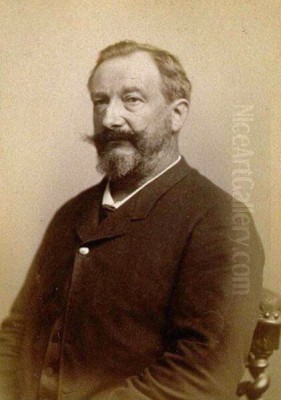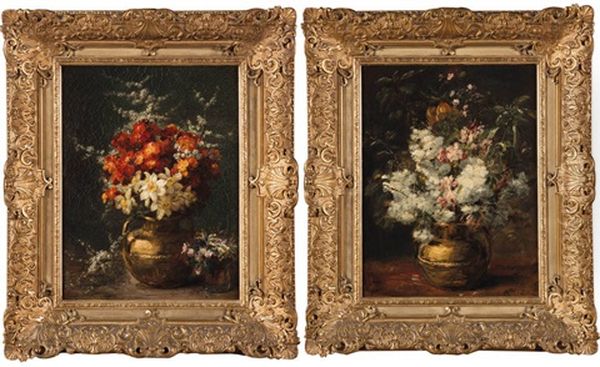
Alexis Kreyder stands as a notable figure in late 19th and early 20th-century French art, primarily celebrated for his exquisite still life paintings, particularly those featuring flowers and fruit. Born in 1839 and passing away in 1912, Kreyder navigated the vibrant and rapidly changing art world of France, carving out a niche with his detailed and aesthetically pleasing compositions. Beyond his easel, he also made a significant, though perhaps less widely known, contribution to the scientific field of viticulture through his detailed illustrations. This dual path marks him as an artist of unique talents and interests.
Origins in Alsace
Alexis Kreyder was born in Andlau, a town nestled in the Alsace region of France. This region, historically shifting between French and German control, possesses a rich cultural tapestry that may have influenced the young artist. While specific details regarding his formal artistic education are not readily available from the provided sources, his later works demonstrate a high degree of technical skill and a keen observational eye, suggesting dedicated training and practice. His French nationality remained a constant throughout his life and career, which unfolded primarily during the Third Republic.
The Enduring Appeal of Still Life
Kreyder dedicated much of his artistic output to the genre of still life. This form of painting, with deep roots in European art history reaching back through masters like the Dutch Golden Age painters to the Renaissance, experienced a continued appreciation in 19th-century France. Artists like Jean-Baptiste-Siméon Chardin had elevated the genre in the 18th century, and Kreyder followed in this tradition, focusing on the beauty found in everyday objects, particularly the bounty of nature. His approach appears rooted in realism, prioritizing accurate depiction, vibrant colour, and the careful rendering of texture.
Capturing Nature's Bounty: Flora and Fruit
Kreyder excelled in capturing the transient beauty of flowers and the luscious appeal of fruit. His works often showcase arrangements that are both naturalistic and compositionally balanced. He paid close attention to the play of light on petals, leaves, and fruit skins, bringing his subjects to life on the canvas. The choice of flowers and fruit allowed him to explore a rich palette, from delicate pastels to deep, saturated hues.

A prime example of his work in this vein is La corbeille de prunes (The Basket of Plums). Dated to the 1870s, this oil on canvas measures 60 x 80 cm and bears the artist's signature in the lower left corner. The painting likely depicts a wicker basket overflowing with ripe plums, showcasing Kreyder's ability to render the soft bloom on the fruit's skin and the interplay of colours. Such works resonated with the tastes of the time, finding a place in bourgeois homes and galleries alongside the more revolutionary movements like Impressionism. His dedication to floral subjects aligns him with contemporaries like Henri Fantin-Latour, who was renowned for his sensitive flower paintings.
Notable Works and Themes
Beyond the plums, other recorded works further illustrate Kreyder's thematic focus. Vase de fleurs (Vase of Flowers), an oil painting measuring 62.5 x 45 cm and also signed lower left, confirms his dedication to floral arrangements. While the specific flowers are not detailed in the source, one can imagine a composition filled with the popular blooms of the era, meticulously arranged and rendered.
Another significant piece mentioned is Roses au vase chinois (Roses in a Chinese Vase). This larger work, measuring 110 x 75 cm and signed distinctively in the lower right corner, introduces an element of the exotic. The inclusion of a Chinese vase points towards the Japonisme and Chinoiserie trends that influenced European art and design throughout the latter half of the 19th century, impacting artists from James McNeill Whistler to Édouard Manet and Claude Monet. This painting was noted in auction catalogues with an estimated value of €3,000 to €5,000, indicating a continued market appreciation for his work. These examples highlight Kreyder's consistent engagement with still life, focusing on natural beauty often presented within domestic settings.
A Unique Contribution: Illustrating the World of Wine
Perhaps one of the most distinctive aspects of Alexis Kreyder's career was his significant involvement in a major scientific publication on viticulture. He collaborated with Jules Troncy to provide illustrations for the monumental Traité général de viticulture: Ampélographie (General Treatise of Viticulture: Ampelography). This seven-volume work, authored by the leading experts Pierre Viala and Victor Vermorel, was published between 1901 and 1910 and remains a landmark in the study of grapevines.
Ampelography, the science of grapevine identification and classification, was critically important, especially in the wake of the phylloxera epidemic that devastated European vineyards in the late 19th century. Accurate identification of grape varieties and rootstocks was essential for replanting and recovery. Kreyder's contribution was substantial: he was responsible for creating hundreds of lithographs for the treatise, including 500 plates printed in colour. These illustrations depicted grape varieties with scientific precision, capturing the morphology of leaves, grape clusters, and canes.
This work required not only artistic skill but also a meticulous attention to detail comparable to that of botanical illustrators like Pierre-Joseph Redouté, famous for his earlier depictions of roses and lilies. Kreyder's illustrations served a vital practical and scientific purpose, aiding researchers, growers, and nurserymen in identifying and understanding different grape cultivars. The source mentions his involvement related to work concerning Portuguese Alentejo wine, likely through illustrating grape varieties pertinent to that region or discussed within the comprehensive scope of Viala and Vermorel's treatise. This project showcases a fascinating intersection of art and science in Kreyder's career.
Kreyder in the Context of His Time
Alexis Kreyder worked during a period of immense artistic ferment in France. While the Impressionists like Claude Monet, Pierre-Auguste Renoir, and Camille Pissarro were revolutionizing landscape and figure painting with their focus on light and fleeting moments, Kreyder largely remained focused on the more traditional genre of still life. His style appears closer to the Realism championed earlier by Gustave Courbet or the meticulous finish found in some Academic painting, rather than the looser brushwork of the Impressionists.
However, the popularity of still life persisted. Artists associated with various movements continued to explore the genre. Édouard Manet, though a key figure in the development of modern art, produced stunning still lifes. Paul Cézanne would later radically deconstruct the genre, but his intense focus on the structure of objects began with traditional still life subjects. Even Vincent van Gogh painted numerous powerful still lifes, including his famous sunflowers.
Within the specific realm of flower painting, Henri Fantin-Latour achieved great success and recognition, exhibiting regularly at the Paris Salon, the official exhibition venue where artists like Kreyder would also likely have sought to show their work. Other contemporaries known for still life included Antoine Vollon. While the provided information does not detail specific interactions, collaborations, or rivalries between Kreyder and these prominent painters, he was undoubtedly aware of the diverse artistic currents swirling around him in Paris and elsewhere in France. His adherence to detailed floral and fruit painting suggests a deliberate choice to excel within an established, appreciated genre. His work for the Ampélographie also aligns him with a tradition of scientific illustration, distinct from but parallel to the fine art movements of the era. We can also consider academic painters like William-Adolphe Bouguereau or realists like Jean-François Millet as part of the broader artistic landscape he inhabited, even if their primary subjects differed.
Legacy, Auctions, and Collections
Alexis Kreyder's legacy is twofold. He is remembered as a skilled painter of still lifes, particularly flowers and fruit, whose works continue to appear in the art market. The mention of pieces like La corbeille de prunes and Roses au vase chinois in auction contexts confirms their circulation among collectors. While the specific institutions that may hold his works in their permanent collections are not detailed in the provided source material, his presence at auction indicates an enduring appreciation for his aesthetic.
Equally important, though perhaps less celebrated in general art history, is his contribution to the scientific documentation of viticulture through his illustrations for the Traité général de viticulture. This work cemented his place in the history of botanical and agricultural science illustration. His detailed and accurate lithographs remain valuable resources and testaments to the crucial role illustration played in disseminating scientific knowledge before the widespread use of photography.
Conclusion: An Artist of Petals and Vines
Alexis Kreyder (1839-1912) represents a dedicated artist who found his voice in the meticulous and beautiful rendering of the natural world, specifically through floral and fruit still life. Working within a long tradition, he created appealing works characterized by careful observation, vibrant colour, and skilled technique. His paintings, such as La corbeille de prunes and Roses au vase chinois, offer a glimpse into the enduring appeal of this genre during the late 19th and early 20th centuries. Furthermore, his extensive work illustrating the seminal Ampélographie by Viala and Vermorel highlights a unique intersection of artistic talent and scientific utility, securing his contribution not only to the art world but also to the important field of viticulture. He remains a figure worthy of recognition for his mastery of detail, whether applied to the delicate petals of a rose or the identifying features of a grapevine leaf.